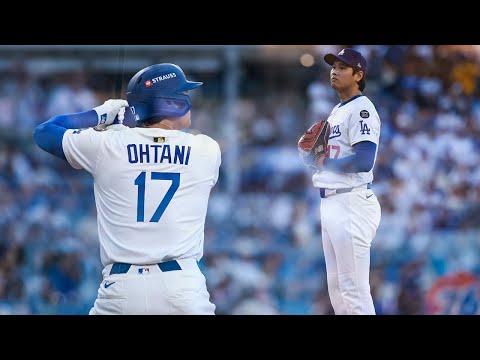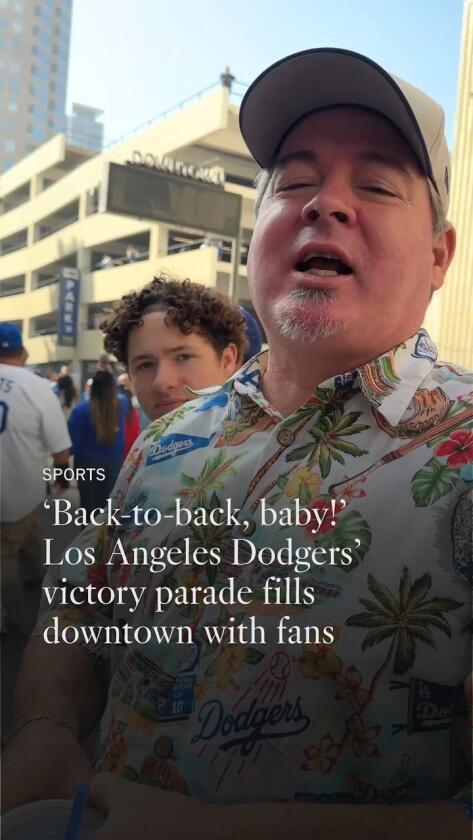11 improbable moments that defined Dodgers’ repeat World Series run
The road to becoming the first repeat World Series champion in 25 years was not a smooth one for the Dodgers, who captured their ninth championship in franchise history when they knocked off the Toronto Blue Jays 5-4 in 11 innings of a Game 7 for the ages.
After winning nine of their first 10 postseason contests, the Dodgers had to slog through a seven-game World Series that included two extra-inning wins — one in 18 innings — and consecutive losses at home that put their season on the brink.
But in the end, the Dodgers emerged with their second consecutive championship and third in six seasons. How did they make it happen? Here are some moments that galvanized the Dodgers’ run to another World Series triumph.
A great escape, with a wheel man
Mookie Betts broached the idea of running the wheel play as the Dodgers tried to hang on for dear life in Game 2 of the NLDS against the Philadelphia Phillies at Citizens Bank Ballpark. In a tribute to executing the fundamentals, Max Muncy pounced on a bunt and Betts tagged out the lead runner at third base to help the Dodgers survive the ninth inning and grab a 2-0 lead in the best-of-five series.
Ohtani’s iconic performance

A look at the three home runs Shohei Ohtani hit in Game 4 of the NLCS.
Based on the first inning alone, Shohei Ohtani would’ve produced an unforgettable performance in Game 4 of the NLCS against the Milwaukee Brewers, striking out three in a row following a leadoff walk as the Dodgers’ starting pitcher and then homering as his team’s leadoff batter to stake himself to an early lead. But Ohtani homered twice more — including a 469-foot blast over the right-field pavilion — and went on to strike out 10 in six innings to help the Dodgers secure their second consecutive NL pennant.
Another complete game by Yamamoto

Yoshinobu Yamamoto had already thrown a complete game in Game 2 of the NLCS, the first one by a Dodgers pitcher since José Lima in 2004. But Yamamoto went into more rarefied air when he threw another one in Game 2 of the World Series in a 5-1 win over the Blue Jays — becoming the first Dodger to throw consecutive postseason complete games since Orel Hershiser in 1988.
Kershaw’s moment
The anguish and heartbreak of Clayton Kershaw‘s postseason history is well known, and the Dodger Stadium crowd braced itself when he entered Game 3 of the World Series with the bases loaded and two outs in the 12th inning. In an eight-pitch battle with the Jays’ Nathan Lukes, Kershaw induced a soft grounder to second baseman Tommy Edman that he had to charge and scoop over with his glove to first baseman Freddie Freeman to escape the jam.
The Will Klein Game

As Game 3 of the World Series dragged into the 15th inning, the Dodgers turned to Will Klein, the last reliever in their bullpen — though Yamamoto was later warming for a potential 19th inning. Klein, acquired by the Dodgers in a minor trade on June 2, threw 72 pitches — the most he’s thrown as a professional — over four scoreless innings to keep the Dodgers in it.
Freeman, the walkoff sequel

In a World Series Game 3 that featured 19 pitchers, 25 position players, 609 pitches thrown and 153 trips to the plate, it was something familiar that won it for the Dodgers in the 18th inning: a Freeman walk-off home run. One year and two days after his iconic walk-off grand slam in Game 1 of the 2024 World Series, Freeman smashed a solo shot to center field to lift the Dodgers to a 6-5 win and a 2-1 series lead.
Kiké Hernández, October hero
Left fielder Kiké Hernández added another chapter to his October legacy in the bottom of the ninth inning of Game 6 with the Dodgers trying to hang on to a 3-1 lead and keep their season alive. With runners on second and third and one out, Hernández played shallow and was in good position to catch a sinking line drive by Andrés Giménez before firing a throw to second baseman Miguel Rojas, who caught it on a bounce to double off the runner at second and force a Game 7.
Miguel Rojas ninth-inning hero
Rojas became the ninth-inning focal point in Game 7 as he came up to bat with the Dodgers trailing 4-3 and two outs away from losing the World Series. Rojas, who had one homer since the All-Star break, worked the count full before hammering a game-tying shot to left. In the bottom of the inning, with the bases loaded and the infield in with one out, Rojas fielded a grounder cleanly and came up firing to force the runner out at home and preserve the tie.
The Catch
One batter later and with the bases still loaded, it was Andy Pages’ turn to be the defensive hero. Inserted mid-inning at center field for his strong arm, Pages found himself using his legs to cover a lot of ground on a deep fly ball to left-center that Hernández was trying to catch over his shoulder before colliding with Pages as the center fielder secured the ball to carry the game into extra innings.
Will Smith, home run hero
As Game 7 entered the 11th inning, it was catcher Will Smith who was in the right place at the right time. Smith, who’d worked his way back into the lineup after suffering a hairline fracture in his right hand in September, turned on a 2-0 slider for his second home run of the series to put the Dodgers in front for the first time in the game.
Yamamoto with the exclamation point

Entering Game 7 during that ninth-inning jam that Rojas and Pages helped him escape, Yamamoto retired the Jays in order in the 10th and then worked around a leadoff double in the 11th, fiedling a sacrifice bunt and then walking a batter before inducing a double play to seal the Dodgers’ repeat championship. For Yamamoto in the World Series, the final tally was three wins, the last coming in relief after throwing 96 pitches the night before in Game 6, and the MVP award.


